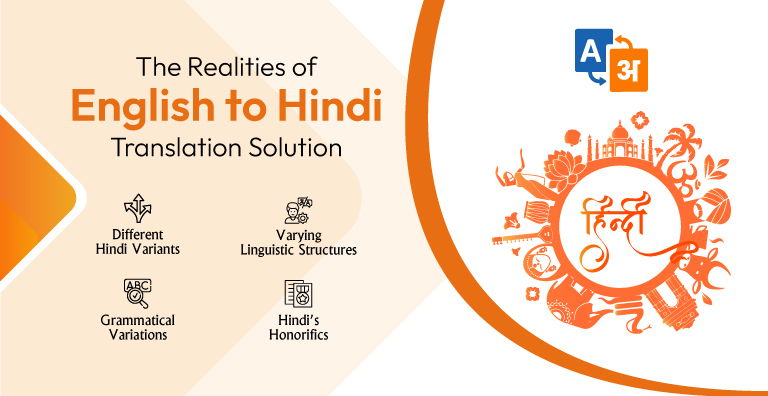As one of the world’s most widely spoken languages (with nearly 575 million speakers), Hindi is a language that businesses cannot ignore during localization. While enabling businesses to access a huge number of speakers, English to Hindi translation helps them establish a foothold in the world’s Hindi-speaking regions.
However, on the other hand, English to Hindi translation isn’t devoid of challenges. The varying nature and origins of both these languages bring numerous roadblocks to a translator’s table putting their abilities to the test. If you look to target Hindi-speaking markets for your business, knowing what challenges these translations can help you prepare for them better. Let’s look at some.
Top 7 Challenges Involved in English to Hindi Translation
From grammatical differences to cultural nuances, you should prepare for these seven English Hindi translation challenges.
1. Different Hindi Variants
In India, particularly, Hindi is spoken across various regions or states. All of them have developed a unique variant of Hindi that has its peculiarities and thus, challenges. Apart from the standard Hindi, some variants include Avadhi, Bhojpuri and Awadhi. Each language is culturally unique and has linguistic variation. These aren’t much different from Hindi but distinct enough to demand an exclusive and personalized translation approach.
Working out these challenges with experts providing professional English-to-Hindi translation services can help you deal with them effectively.
2. Varying Linguistic Structures
Although English and Hindi holistically belong to the Indo-European language family, they have different origins. While English is derived from Ingavaeonic languages brought to Britain, Hindi has its roots in Sanskrit.
Accordingly, both these languages have unique grammatical structures and writing systems. Translating English to Hindi requires translators to deal with metaphors, idioms and nuances. These aspects demand a profound understanding of both languages to convey the right meaning.
The reality refers to achieving linguistic equality, which can prove challenging if you do not have experts dealing with these languages.
3. Grammatical Variations
English and Hindi have numerous grammatical variations. One of the most common ones is the sentence structure. English follows a subject-verb-object (SVO) pattern, whereas Hindi usually adheres to subject-object-verb (SOV).
For instance, in English, you say I am eating an apple, which follows a subject-verb-object pattern. However, in Hindi, you say मैं सेब खा रहा हूँ| (Main seb kha raha hoon). Here, seb which means an apple comes before the verb kha, which means to eat or eating (in this context).
Although this is the standard way of saying the sentence in Hindi, the order of words may change depending on the context. Thus, you can also say the sentences as सेब खा रहा हूँ मैं|, especially when you want to emphasize apple. Thus, colloquially, the object may come in the beginning.
Translators should be aware of these grammatical differences to ensure accurate and linguistically accurate translations.
4. Different Vocabulary and Idioms
As two distinct languages that have been in use for centuries, English and Hindi have developed their vocabularies and idioms. Not all the words in English would have a Hindi equivalent and vice versa. For example, spam is a word that doesn’t have a corresponding Hindi word.
Also, English uses many words like Guru, Avtar, Nirvana, etc., although they aren’t English words and are derived from the Sanskrit-based Hindi.
On the other hand, many English idioms do not have a Hindi equivalent. For example, making hay while the sun shines, doesn’t have a Hindi match, especially when it comes to translating it. It has another idiom that isn’t a translated match but has a similar meaning. It could be मौक़े का फ़ायदा उठाना (mauke ka faayda uthana). Although with different words, both idioms mean the same.
5. Cultural Distinctness
Translation isn’t about substituting words but taking care of cultural context and nuances as well. Hindi has its roots in Indian culture. Hence, while working on English to Hindi translation, the translator should have an understanding of both cultures, traditions, customs, and norms. It is also because what suits English may not necessarily be relevant or culturally suitable in Hindi.
6. Hindi’s Honorifics
Hindi is enriched with a system of honorific and polite forms of addressing called tatsam and tadbhav. Hindi speakers use them to convey respect.
For example, in English, you is used for elders, equals as well as younger people. However, Hindi has words like आप (aap), तुम (tum), and तू (tu) to address someone as you. Aap is used for elders or seniors. On the other hand, tum is used for equivalents and tu is used for juniors.
Nevertheless, in India’s northern parts, especially Delhi, aap is generally used for everyone, whether older or younger. It also is used in formal settings, where tum sounds a little unprofessional or casual and tu is entirely unacceptable.
7. Differentiating Between Literal and Functional Translation
Another challenge or reality of English to Hindi translation is the dilemma between using literal and functional translation. Literal refers to word-to-word conversion of text. On the other hand, functional translation emphasizes conveying the intended meaning naturally and in a culturally correct way. The key to meeting the needs is to be able to identify the right translation approach and balance both as required.
Ace English Hindi Translations with LinguaSol’s Linguify!
Linguify is a premium translation tool with expertise in over 200 languages, including English and Hindi. The low code and no-code tool that allows seamless need-based changes also ensures swift change management. Additionally, while ensuring accurate translations, Linguify also supports local SEO, thereby benefitting businesses across local searches as well. It is a comprehensive and well-researched translation solution that’s already serving hundreds of companies from numerous business domains. You also can benefit from it and leverage language as a medium to connect with your Hindi-speaking prospects.
Email LinguaSol at sales@linguasol.net to learn more about Linguify and navigate its numerous features and functionalities.
Ref. No- LSB7241048

